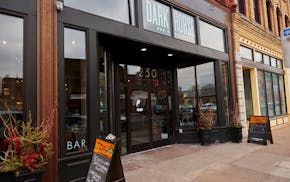Amy Carter knows cookies.
At the start of her long and impressive culinary career, she owned and operated a bakery. Carter capped that invaluable experience with a faculty position at the former Art Institutes International Minnesota in downtown Minneapolis, where she guided and inspired a generation of pastry chefs. She's currently one of four chefs for product development at Lunds & Byerlys, creating new items for the supermarket chain's bakery, deli, meat and seafood departments.
For the past six years, Carter has also supervised a gigantic task: leading a crew of volunteer pastry professionals as they bake the semifinalist recipes in the Star Tribune Holiday Cookie Contest. She's also an enthusiastic home baker, which means that, during the holiday season, her Minneapolis kitchen gets a strenuous workout.
So, who better to turn to for cookie-related concerns? Here's Carter on ...
Baking sheets: "I use the heavy-duty half-sheet pans, something with a bit of a lip so the cookies don't slide. And, always, parchment paper. The old cookie sheets were really thin, and what you want is something that's heavy- duty, because that slows down the heat on the bottom, and prevents cookies from burning. Burned-on-the-bottom cookies are a sad thing."
Oven thermometers: "Learning how your oven works is so important. You need to get to know what the true temperature is, and that makes an oven thermometer essential. You can always make adjustments, as long as you know the temperature that you have."
Convection ovens: "To me, underbaked and overbaked cookies are two of the world's great disasters. There is this perfect point for most cookies, where the outside is nice and firm, and it's cooked through the middle, but it's not hard. For me, finding that perfect balance is much better with a convection oven. It's basically a fan blowing the heat around, and it's the joys of having an air fryer in an oven. I'm a huge advocate of convection ovens because, for a lot of regular cooking, a convection oven is faster, operates at a lower temperature and leads to better browning and caramelization.
"For baking cookies, a convection oven is perfect. With regular ovens, it's a bottom-only heat, which means you don't get enough heat on top for setting and sealing the proteins. Because the heat circulates in a convection oven, you can bake two trays of cookies at a time. I'd never do that in a non-convection oven."
Baking stones: "I use one, always, in my non-convection oven, to help even out the temperature. I place it in the center, and it forces the heat — which comes from the bottom of the oven — to go around it."
Baking temperature: "For cookies, 325 degrees is the temperature of choice in a convection oven. If it's non-convection, I go with 340 degrees."
Unsalted butter: "You have more control with the salt level if you start with unsalted butter. It used to be that absolutely all I ever used was unsalted butter, and that's because of the differing quality of salted butter. Butter makers use salt to disguise the quality of the butter. But if you use a consistent-quality salted butter, then you can bake with salted butter.
"Whatever the star ingredient is, that's where you want to spend the money. In cookies, that's often butter. Land O'Lakes is good quality. For home use, as long as I can manage it, I use Hope Creamery butter, and there's a good Vermont butter that I like. I like Kerrygold, too. But you have to be careful so you don't get a super-fatty butter, because that higher butterfat content can make the cookie spread too much.
"In class, we'd bake the same recipe with a bunch of different butters, and that would demonstrate that there really is a difference in quality. I'll be making Buttery Blueberry Buttons [a 2021 contest finalist], and I'll be buying three different butters and trying them out."
Eggs: "When I'm baking cookies, I always use organic, extra-large eggs. I like eggs at room temperature, even though there usually aren't a lot of eggs in cookies. That's because a cold egg will chill down the butter — which should also always be at room temperature — and that will change the way the cookie bakes. It's a small, delicate balance. If the dough is too cold, it won't spread the way you want it to spread."
Salt: "Don't use iodized table salt, or kosher salt. Use a good-quality fine sea salt. One of my new favorite ingredients is an alderwood smoked sea salt. I'm going to experiment this year with Whiskey Gingers [the 2019 contest winner, find the recipe at startribune.com/cookies], I'm going to put that smoked sea salt in that cookie and see what happens."
Cane vs. beet sugar: "With any kind of candy making, it's always cane sugar. Always. Does it work with beet? Yes, but not all of the time. But in cookie baking, I haven't found a huge difference."
Vanilla extract: "Yes, true vanilla extract can be expensive, but the subtlety of what it adds is just so worth it, and you'll notice the difference. It's the floralness and earthiness of vanilla, that's what makes it worth the price. If it's an outrageously priced vanilla, just put in a bit less. If it calls for a teaspoon, put in half. If it's a good quality, that quality will show.
"If you're going to use vanilla, use the real thing, not something that's a chemical with the right color, because that's what fake vanilla is, essentially. Fake vanilla is a derivative of wood pulp, and do you really want to eat that?"
Keeping cool: "If you're refrigerating dough, don't refrigerate it in a ball. Put the dough into a flat rectangle or disk. That way, the temperature will be nice and even all the way through, and it will cool faster. If it's in a ball, the outside of the dough will be too cold, and the center won't be chilled enough."
Scoops: "Absolutely, you should use a portion scoop. There's so much less hassle involved, and they make such a difference in terms of cookies baking evenly. They're so easy to use, too. I taught my grandsons how to use them.
Also, don't make gigantic cookies, especially at the holidays, when people want to eat a variety. Make them small, and approachable. A small scoop will make that easy to do."
Storage: "Once cookies are baked, it's best to store them in an airtight container, freeze them and then bring them to room temperature to serve. In Minnesota, one of the best things about this time of year is that you can stick them in the garage — above the level of the mice — and they'll stay nice and cold. But sitting in a tin, on the counter, for days? That's not ideal."
Cookie tray strategizing: "Variety is the key. Think about creating an assortment where there will be something to appeal to everyone. Variety is also important from the baker's perspective. Have a few cookies that are really easy to make, then you can spend some time making some of the time-consuming recipes. Not everything has to be a ton of work. Start with the easy ones, and then build an inventory."
Holiday baking: "Baking cookies is a nice way to help make yourself feel better, because it feels good to give them away, and you get to spread that joy around. Cookies are perfect because very few people can resist them. They may not like pie, or cake, or ice cream. But cookies? You can almost always find a cookie to tempt someone."

The 5 best things our food writers ate this week

A Minnesota field guide to snow shovels: Which one's best?

Summer Camp Guide: Find your best ones here

Lowertown St. Paul losing another restaurant as Dark Horse announces closing

